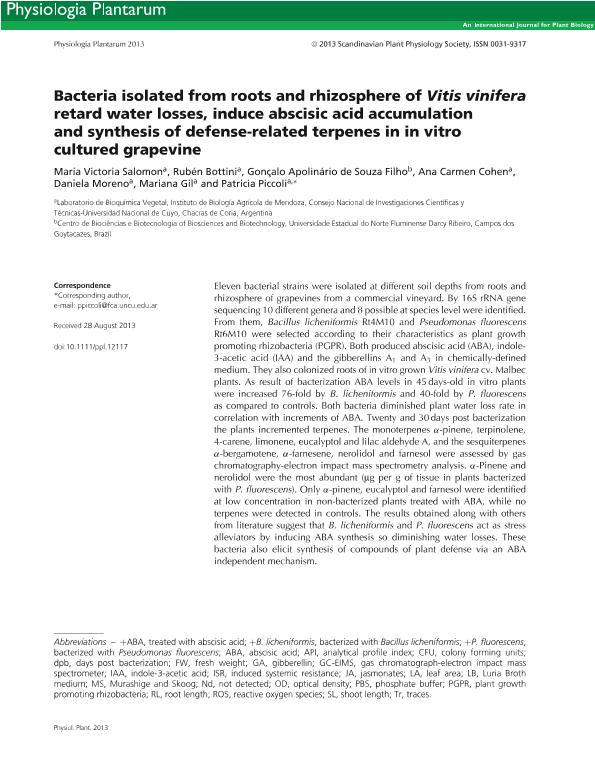Mostrar el registro sencillo del ítem
dc.contributor.author
Salomon, María Victoria

dc.contributor.author
Bottini, Ambrosio Rubén

dc.contributor.author
Souza Filho, Gonçalo Apolinario de
dc.contributor.author
Cohen, Ana Carmen

dc.contributor.author
Moreno, Daniela Maria del Valle

dc.contributor.author
Gil, Mariana
dc.contributor.author
Piccoli, Patricia Noemí

dc.date.available
2017-08-23T17:54:22Z
dc.date.issued
2014-07-29
dc.identifier.citation
Salomon, María Victoria; Bottini, Ambrosio Rubén; Souza Filho, Gonçalo Apolinario de ; Cohen, Ana Carmen; Moreno, Daniela Maria del Valle; et al.; Bacteria isolated from roots and rhizosphere of Vitis vinifera retard water losses, induce abscisic acid accumulation and synthesis of defense-related terpenes in in vitro cultured grapevine; Wiley Blackwell Publishing, Inc; Physiologia Plantarum; 151; 4; 29-7-2014; 359-374
dc.identifier.issn
0031-9317
dc.identifier.uri
http://hdl.handle.net/11336/22863
dc.description.abstract
Eleven bacterial strains were isolated at different soil depths from roots and rhizosphere of grapevines from a commercial vineyard. By 16S rRNA gene sequencing 10 different genera and 8 possible at species level were identified. From them, Bacillus licheniformis Rt4M10 and Pseudomonas fluorescens Rt6M10 were selected according to their characteristics as plant growth promoting rhizobacteria (PGPR). Both produced abscisic acid (ABA), indole-3-acetic acid (IAA) and the gibberellins A1 and A3 in chemically-defined medium. They also colonized roots of in vitro grownVitis vinifera cv. Malbec plants. As result of bacterization ABA levels in 45 days-old in vitro plants were increased 76-fold by B. licheniformis and 40-fold by P. fluorescens as compared to controls. Both bacteria diminished plant water loss rate in correlation with increments of ABA. Twenty and 30 days post bacterization the plants incremented terpenes. The monoterpenes α-pinene, terpinolene, 4-carene, limonene, eucalyptol and lilac aldehyde A, and the sesquiterpenes α-bergamotene, α-farnesene, nerolidol and farnesol were assessed by gas chromatography-electron impact mass spectrometry analysis. α-Pinene and nerolidol were the most abundant (μg per g of tissue in plants bacterized with P. fluorescens). Only α-pinene, eucalyptol and farnesol were identified at low concentration in non-bacterized plants treated with ABA, while no terpenes were detected in controls. The results obtained along with others from literature suggest that B. licheniformis and P. fluorescens act as stress alleviators by inducing ABA synthesis so diminishing water losses. These bacteria also elicit synthesis of compounds of plant defense via an ABA independent mechanism.
dc.format
application/pdf
dc.language.iso
eng
dc.publisher
Wiley Blackwell Publishing, Inc

dc.rights
info:eu-repo/semantics/openAccess
dc.rights.uri
https://creativecommons.org/licenses/by-nc-sa/2.5/ar/
dc.subject
Grapevine
dc.subject
Bacillus Licheniformis
dc.subject
Pseudomonas Fluorescens
dc.subject
Terpenes
dc.subject.classification
Bioquímica y Biología Molecular

dc.subject.classification
Ciencias Biológicas

dc.subject.classification
CIENCIAS NATURALES Y EXACTAS

dc.title
Bacteria isolated from roots and rhizosphere of Vitis vinifera retard water losses, induce abscisic acid accumulation and synthesis of defense-related terpenes in in vitro cultured grapevine
dc.type
info:eu-repo/semantics/article
dc.type
info:ar-repo/semantics/artículo
dc.type
info:eu-repo/semantics/publishedVersion
dc.date.updated
2017-07-13T17:53:54Z
dc.journal.volume
151
dc.journal.number
4
dc.journal.pagination
359-374
dc.journal.pais
Reino Unido

dc.journal.ciudad
Londres
dc.description.fil
Fil: Salomon, María Victoria. Consejo Nacional de Investigaciones Científicas y Técnicas. Centro Científico Tecnológico Conicet - Mendoza. Instituto de Biología Agrícola de Mendoza. Universidad Nacional de Cuyo. Facultad de Ciencias Agrarias. Instituto de Biología Agrícola de Mendoza; Argentina
dc.description.fil
Fil: Bottini, Ambrosio Rubén. Consejo Nacional de Investigaciones Científicas y Técnicas. Centro Científico Tecnológico Conicet - Mendoza. Instituto de Biología Agrícola de Mendoza. Universidad Nacional de Cuyo. Facultad de Ciencias Agrarias. Instituto de Biología Agrícola de Mendoza; Argentina
dc.description.fil
Fil: Souza Filho, Gonçalo Apolinario de. Universidade Estadual Do Norte Fluminense Dary Ribeiro. Centro de Biociencias e Biotecnologia of Biosciences and Biotechnology; Brasil
dc.description.fil
Fil: Cohen, Ana Carmen. Consejo Nacional de Investigaciones Científicas y Técnicas. Centro Científico Tecnológico Conicet - Mendoza. Instituto de Biología Agrícola de Mendoza. Universidad Nacional de Cuyo. Facultad de Ciencias Agrarias. Instituto de Biología Agrícola de Mendoza; Argentina
dc.description.fil
Fil: Moreno, Daniela Maria del Valle. Consejo Nacional de Investigaciones Científicas y Técnicas. Centro Científico Tecnológico Conicet - Mendoza. Instituto de Biología Agrícola de Mendoza. Universidad Nacional de Cuyo. Facultad de Ciencias Agrarias. Instituto de Biología Agrícola de Mendoza; Argentina
dc.description.fil
Fil: Gil, Mariana. Consejo Nacional de Investigaciones Científicas y Técnicas. Centro Científico Tecnológico Conicet - Mendoza. Instituto de Biología Agrícola de Mendoza. Universidad Nacional de Cuyo. Facultad de Ciencias Agrarias. Instituto de Biología Agrícola de Mendoza; Argentina
dc.description.fil
Fil: Piccoli, Patricia Noemí. Consejo Nacional de Investigaciones Científicas y Técnicas. Centro Científico Tecnológico Conicet - Mendoza. Instituto de Biología Agrícola de Mendoza. Universidad Nacional de Cuyo. Facultad de Ciencias Agrarias. Instituto de Biología Agrícola de Mendoza; Argentina
dc.journal.title
Physiologia Plantarum

dc.relation.alternativeid
info:eu-repo/semantics/altIdentifier/doi/http://dx.doi.org/10.1111/ppl.12117
dc.relation.alternativeid
info:eu-repo/semantics/altIdentifier/url/http://onlinelibrary.wiley.com/doi/10.1111/ppl.12117/abstract
Archivos asociados
